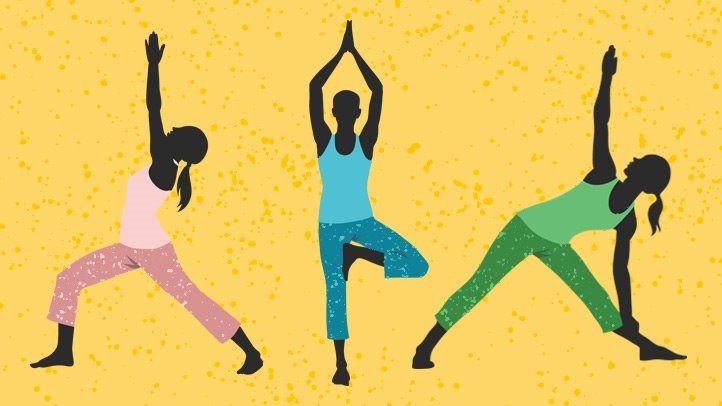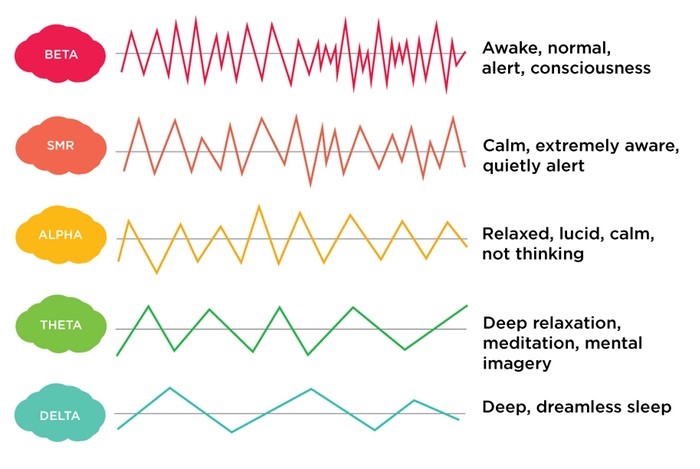
Yoga for brain health
Yoga effects on brain
We all know that exercise has a powerful effect on our bodies and brains, and now we also know that meditation or mindfulness practices have a great influence on our minds and brains too. Although yoga is not necessarily classified as a form of exercise it is most definitely a practice of mindfulness – a meditative movement practice if you will – that holds great mental health benefits. The health benefits of yoga are endless. Some might see it as a spiritual practice (meditation practices) or more of physical practice (asana practice) but it still holds the same potential to change us on a chemical level.
There is research that supports the benefits of yoga for mental health and cognitive function. Increased body awareness, decreases stress levels (by deactivating the stress response), reduces muscle tension, inflammation, and sharpened attention are some of the benefits of yoga. The positive benefits of yoga on mental health have made it an important practice tool for therapists.
Yoga enhances our social lives by connecting us with a sense of community. As we connect with others symptoms of depression, attention deficit disorder, hyperactivity, and sleep disorders can also be reduced.
Health has many pillars to it and should be viewed with a holistic approach – it does not just consist of exercise and diet but our social and professional lives, as well as the relationships we have with ourselves and others, play a big role in our overall wellbeing too.
Studies have shown that yoga has a significant effect on a chemical in our brains called GABA (or gamma-aminobutyric acid). In individuals that suffer from anxiety, depression, or other mood disorders GABA levels are low. GABA helps to regulate our nerve activity and through practicing yoga GABA increases greatly.
The answer lies within the field of neurobiology — specifically, what happens in the brain during these practices. In a recent review article published by the Journal of Clinical Psychiatry, researchers from University College London reported: “that yogic relaxation techniques may be effective treatments for major depressive disorder”. They reviewed over 30 controlled studies involving more than 2,000 patients and concluded that “the results support the use of hatha yoga interventions for the treatment of MDD.”
Training the Brain Regions – a sharper, bigger, and stronger brain through yoga
Yoga leads to physical changes in our brain structures. It has been shown to improve memory function by increasing blood flow to the hippocampus — an area of the brain associated with learning and memory.
In one study published last year, researchers found that people who practiced hatha yoga three times per week over eight weeks showed improved performance on tests measuring their ability to remember words they had just read compared to those who did not practice yoga. The same group also performed significantly better than another group of participants at remembering pictures after reading them.
Mindfulness can be seen as training for the brain. Similar to lifting weights in the gym to build muscles – yoga can be used to build brain cells and develop the function of the brain by creating new neural connections or thought patterns this is known as neuroplasticity. The brain quite literally grows stronger and bigger which enhances cognitive skills such as memory, attention, awareness, thought, learning, and language.
Scans using MRI and FMRI technology done in studies have shown that yoga leads to changes in cortical thickness as the thickening of the cerebral cortex and increased development in grey matter in the brain takes place. The cerebral cortex controls information processing, the formation of thoughts, and emotional regulation or emotional reactivity centers. Furthermore the hippocampus, the area of the brain that controls learning and memory, also shows evidence of further development.
These areas of the brain are most affected by age and when we get older they tend to disintegrate which is why the way we form thoughts, memory, and learning is hindered. This suggests that doing yoga counteracts age-related declines in cognitive skills. Even better… the more you do yoga the more prevalent these benefits on the brain show up. So, having a regular yoga practice is directly proportional to these benefits.
How Yoga effects our brainwaves
Our brains operate on various brainwaves which puts our body and brains in a different state of being or activity and relates to different cognitive and emotional functioning.
1. Alpha Brainwaves – low amplitude (8 -13Hz)
Refers to the state of ease and calm. Decrease in pain and increase in memory.
2. Beta – (12 – 38Hz)
Refers to the state of alertness and being awake. Happens when we are actively concentrating and highly focused on a task. It decreases feelings of anxiety while increasing feelings of control.
3. Delta (lowest frequency – 0.5 – 4Hz)
Refers to the state of deep sleep
4. Theta (4 – 7 Hz)
Refers to the state of deep meditation and relaxation. Reduces anxiety while increasing our mind’s absorbable capacity for knowledge. This is where we build a higher sense of intuition.
5. SMR (12.5 – 15Hz)
Refers to being calm but hyper-aware state. This is where we achieve our ‘states of flow’.
6. Gamma (highest amplitude – 38 – 100 Hz)
Refers to the state of thought formation and processing. A highly active state increases our creativity, task processing, and learning patterns.

It’s easy to see why yoga practices and brain waves have an interesting relationship and how the combination of deep breathing, stretches, and meditation integrates to have positive effects on our brainwaves.
Previous studies have concluded the following of some changes in brainwaves after yoga:
Changes in alpha brain waves associated with decreased pain and increased calmness were found after breathing, meditation and posture-based yoga practices.
Increases in beta wave activation, which is linked with improved task performance, were related primarily to breathing based yoga (pranayama). These included practices designed to achieve both activation (e.g. Kapalabhati) and relaxation (e.g. Anuloma Ujjayii).
Theta wave activation, which is associated with repetitive tasks, decreases in anxiety and increases in focus, was found to increase after both asana (posture-based) and pranayama (breathing-oriented) practices.
“Researchers say it is the relaxation response that accompanies these mind and body practices that lead to many improvements to physical and mental health.
A new study from investigators at the Benson-Henry Institute for Mind/Body Medicine at Massachusetts General Hospital (MGH) and Beth Israel Deaconess Medical Center (BIDMC) finds that the deep, physiological state of rest induced by such practices produces immediate positive change in the expression of genes involved in immune function, energy metabolism, and insulin secretion.”
How Yoga causes a deep state of physiological relaxation?
The feelings of calm and tranquility take place on a neurobiological level as all other emotions and feelings do too. These feelings don’t just come out of nowhere. It comes down to the brain and body stimulation and how that happens simultaneously during yoga.
Activities that we perceive as ‘relaxing’, studies show might not be all that relaxing after all. Socializing with friends (or rather laughing to be more specific) or playing your favorite sport within a non-competitive context still involves the body pumping adrenaline to the brain, heart, and muscles to perform these activities. This leads to the body still holding on to a certain amount of biochemical tension as the face contorts to laugh or the muscles contract to play a game of squash.
For relaxation to take place on a nerve and cellular level we need to shift these biochemical processes of the ‘excited and tense state’ to the ‘deeply relaxed and restorative state’.
When we do a yoga class this is exactly what happens as it involves the physical body moving lead by the breath. Deep and intentional breathing activates the parasympathetic nervous system, lowers adrenaline and cortisol levels (our stress hormones), and deactivates the sympathetic nervous system. Our body then enters a state of ‘rest and digest’ rather than ‘flight, fight, freeze or fawn.

Neuroplasticity and Yoga
Neuroplasticity refers to the gradual changes of thought patterns that occur in our brain networks due to the brain making new neural connections as a way to protect us from anxiety and stress or even trauma. There are many chemicals involved in our brain when this happens.
An important factor to note is the chemical BDNF, a brain-derived neurotrophic factor, which helps regulate synaptic plasticity and promotes the survival of nerve cells. Yoga has been shown to not only decrease cortisol but also drastically increase the production of this chemical which leads to our brains constantly developing and changing.
Through this and other processes, we start to notice shifts in the way we think or perceive things as we make new neural connections on a biochemical level. This is what some might refer to as reaching a state of ‘awakening’ as it allows us to realize and come to terms with thoughts and ways of doing that might not serve us anymore – in turn, this helps us deal with past traumas or struggles as we learn to let go and shift past them by turning to new ways of thinking.
Do these brain changes occur in all mindfulness practices or only yoga?
We all know that physical exercise, in general, is good for our brains and bodies. Our bodies are made to move!
So, how is Yoga different?
What makes the practice of yoga stand out as a mindfulness practice is that it combines the mind and the body with equal awareness. The combination of physical yoga poses, breathing exercises or breathing techniques, and meditative qualities of mental introspection and relaxation techniques is what gives yoga the unique edge and drastically increases the mental benefits and the positive effects on the above-mentioned brain regions.
Interestingly enough the form of yoga doesn’t matter all that much on the effect it has on our brains. It is, however, the nature of the mind-body exercise (the physical and the mental elements) that works in harmony which allows these changes to occur. Yin, Vinyasa, Iyengar, Power Yoga, Restorative, Ashtanga, etc. all reap the same beneficial neurological changes. Tai Chi holds similar properties.
Furthermore, where you practice yoga does not make much of a difference either but studies have shown that doing in-studio yoga classes lead by a yoga teacher rather than a self-practice at home has the added benefit of social interaction and energetic exchanges. As mentioned previously a sense of community involvement is one of our pillars of holistic wellbeing and health.
Contradictory to that, practicing by yourself allows you to go deeper and introspect further or even physically follow your own body’s cues with what you need, which strengthens your sense of intuition and trust in yourself, rather than feeling judged for taking “child’s pose” when everybody is in their 8th chaturanga… as always pros and cons to both. You can go at your own pace and personalize your practice completely which adds another element to the concept of yoga being a form of mindfulness meditation.
In conclusion, there are many different forms of yoga and they all work towards similar goals but having a regular practice of yoga and integrating it into our everyday life can have great effects not only on our bodies but in the long run it physically and chemically changes the nature of our brains.



